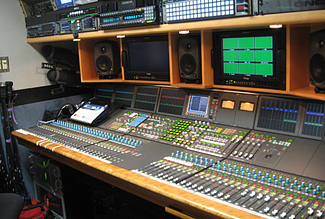Calrec Cures Console Cynic's Complaints

Dome Productions has Calrec consoles installed in seven of its mobile production vehicles.
TORONTO
Ensuring that the broadcast of a live concert or sporting event comes together at the scheduled time means successfully matching operator skills with technical equipment. Like a battle plan, an audio deployment and execution plan is built on a multitude of resources including microphones, patched circuits, playback sources, coordination feeds, and—tying it all together—the audio console.
But this battle plan is in the area of television production, and broadcasting is not intended to be confrontational. The logistical deployment of audio is supposed to result in excellent sound quality. However, things don't always go as planned. And when they don't, somebody has to make extraordinary efforts to save the day. If he succeeds, he's a hero.
My company, Dome Productions, has been in the mobile production unit business for more than 20 years and has eight production vehicles, including six HD trucks. Of those, seven are equipped with Calrec audio consoles. We work with a lot of contract audio operators, and most of the time they're glad to see a Calrec console.
Recently, however, we had a different experience—one that required our own audio person in charge (AIC) to be a hero. It happened on a musical production in Atlantic City, N.J. We had confidence in the equipment that we brought to the show, but when the local mix engineer saw the 72-fader Calrec Alpha 100, he mistakenly labeled it a "sports console" and became distraught about using it for a music show.
Luckily, our crew included an AIC who was in the line of fire for the mix engineer's first impression, and knew how to handle it.
This situation illustrates a paradox in broadcast technology: it has to be complicated, yet simple. In other words, the technology must have the comprehensive tool set and power for a complex production, but must also be easy to use. In this case, the engineer did not immediately recognize that Alpha resolves that paradox.
All of Calrec's current consoles rely on Bluefin HDSP, which puts a lot of processing power in a compact package. Small size is important for equipment in a broadcast truck, and speed and power are necessary to meet the demands of broadcasting 5.1 surround sound.
Traditionally, setup for audio has been based on strategically placed patch cords. Creating this setup visually reinforces the audio operator's design. With the advent of digital consoles, programming replaces physical patches, but the Calrec Alpha enables these programmed patches to be deployed in a fashion that provides a familiar and easily visualized scheme.
MAKING EVERYONE HAPPY
Our AIC showed the mix engineer how this could be accomplished by using the Alpha console's assignable control surface, which affords direct access to most console functions. As a result, the engineer could set up the board to achieve what he wanted, then recall that setup instantly at the appointed time.
As the day wore on and the Alpha console's capabilities and performance were demonstrated, the local engineer's opinion continued to improve. By the time the show started, we all felt confident and comfortable about its success, and the mix engineer's opinion of the Alpha console had done a complete 180. He was glowing—and our AIC was a hero.
Mike Johnson is director of engineering at Dome Productions. He's been with the company for 13 years. He may be contacted atmejohnson@domeprod.com.
For additional information, contact Calrec at 201-762-6569 or visitwww.calrec.com.
Get the TV Tech Newsletter
The professional video industry's #1 source for news, trends and product and tech information. Sign up below.
